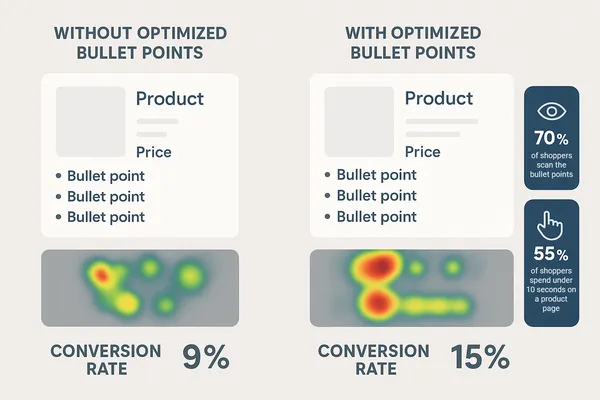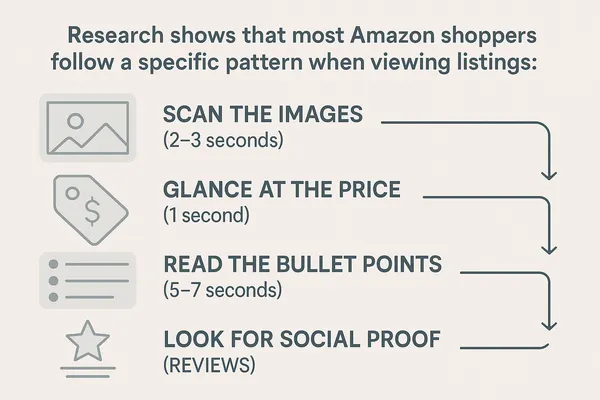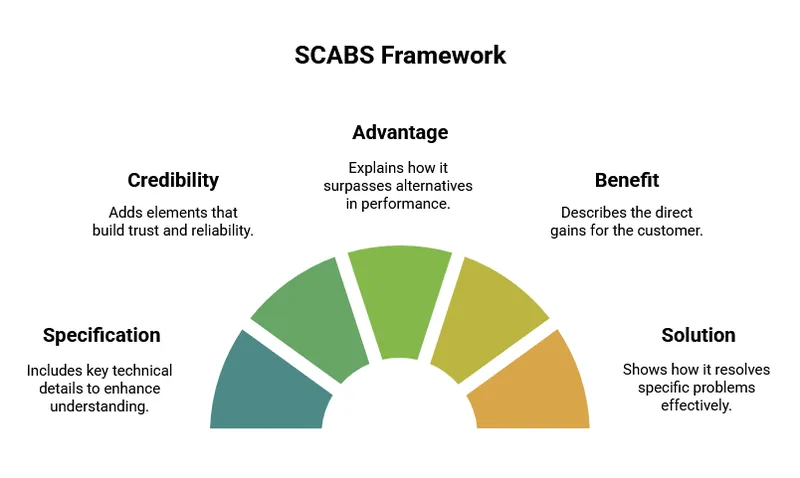
How To Write Amazon Bullet Points That Convert in 2025
Table of Contents
In today’s competitive Amazon marketplace, your product bullet points can make or break your sales. These short, punchy lines of text serve two critical purposes: they help shoppers make quick buying decisions and boost your listing’s search visibility.
Here’s what makes bullet points particularly effective:
- They catch the eye of scanning shoppers
- They break down complex information into digestible chunks
- They highlight key benefits that drive purchases
- They improve your product’s searchability
In this fluff-free, 100% actionable guide, you’ll learn how to craft bullet points that not only inform but convert browsers into buyers.
I. Understanding Amazon Bullet Point Fundamentals
What Are Amazon Bullet Points?
Bullet points, also known as “Key Product Features,” appear prominently in your Amazon listing, right below the pricing information. They’re one of the first things shoppers see when they land on your product page.

Technical Specifications and Guidelines
Amazon provides specific rules for bullet points:
- Maximum 500 characters per bullet
- Usually limited to 5-6 bullets
- No HTML or special characters
- Plain text format only
- All caps for headers (optional)
Allowed:
- Product features and benefits
- Technical specifications
- Compatibility information
- Warranty details
Not Allowed:
- Promotional language like “sale” or “free shipping”
- Price information
- Shipping details
- Company-specific information
- Time-sensitive claims
How Amazon’s Algorithm Uses Your Bullet Points
Your bullet points play a big role in how Amazon’s search algorithm ranks your product. The algorithm scans these points for relevant keywords that match shopper searches. However, it’s essential to know that keywords in bullet points carry less weight than those in your title, but more than those in your product description.
III. The Psychology Behind High-Converting Bullet Points
Understanding how shoppers read and process bullet points is crucial for writing ones that convert.
How Shoppers Read Listings
Research shows that most Amazon shoppers follow a specific pattern when viewing listings:
- Scan the images (2-3 seconds)
- Glance at the price (1 second)
- Read the bullet points (5-7 seconds)
- Look for social proof (reviews)

When reading bullet points, shoppers go through three quick mental stages:
Initial Scan (1 second)
- Looking for relevant keywords
- Checking for easy readability
- Spotting numbers and specifics
Value Assessment (2-3 seconds)
- Matching features to their needs
- Comparing with other options
- Looking for unique benefits
Trust Verification (1 second)
- Checking for credibility markers
- Looking for specific details
- Seeking proof of claims
Emotional Triggers That Drive Purchases
Effective bullet points tap into these key emotional triggers:
Fear of Missing Out (FOMO) “Premium-grade materials ensure lasting durability”
Problem Solution “Ergonomic design eliminates wrist strain during extended use”
Status and Identity “Professional-grade performance trusted by industry experts”
Security and Trust “Backed by our 2-year warranty and US-based support”
Convenience and Ease “Setup takes just 2 minutes with no tools required”
Building Trust Through Specifics
The key to credibility is being specific with your claims:
Weak: “Long-lasting battery” Strong: “18-hour battery life tested under heavy use”
Weak: “High-quality materials” Strong: “Aircraft-grade aluminum construction”
Weak: “Helps you sleep better” Strong: “Fall asleep 45% faster with our patented cooling technology”
Remember: The key to high-converting bullet points is balancing emotional appeal with concrete facts. Your bullet points should make shoppers feel confident while giving them the specific information they need to make a decision.
IV. The Essential Formula for Writing Converting Bullet Points
The difference between a good bullet point and a great one often comes down to structure. Let’s explore the proven formula that top Amazon sellers use to create bullet points that both inform and persuade.
The Benefit-First Approach
Always lead with benefits, not features. Here’s why:
- Features tell, benefits sell
- Shoppers care about what’s in it for them
- Benefits create emotional connections
- Features support the benefits’ claims
For example:
Feature-First (Weak): “Made with premium memory foam” Benefit-First (Strong): “Wake up refreshed and pain-free thanks to premium memory foam support”
The SCABS Formula
The SCABS formula is a powerful framework for writing compelling bullet points:
- Specification: Include a key technical detail
- Credibility: Add trust-building elements
- Advantage: Explain how it’s better than alternatives
- Benefit: Describe what’s in it for the customer
- Solution: Show how it solves a specific problem
Here’s the formula in action:
“[S] Using medical-grade silicone, [C] trusted by leading hospitals, [A] our extra-thick design [B] ensures maximum comfort while [S] eliminating wrist strain during long work hours.”

Power Words That Drive Action
Strategic use of power words can significantly boost conversion rates. Here are the most effective categories:
Trust Words:
- Guaranteed
- Proven
- Certified
- Tested
- Trusted
Urgency Words:
- Essential
- Critical
- Must-have
- Limited
- Exclusive
Benefit Words:
- Effortless
- Instant
- Powerful
- Revolutionary
- Breakthrough
Balancing Technical and Emotional Content
The best bullet points combine hard facts with emotional benefits:
Technical Element + Emotional Benefit = Converting Bullet Point
Examples:
- “2400 DPI optical sensor (technical) for lightning-fast gaming reactions (emotional)”
- “Medical-grade stainless steel (technical) gives you peace of mind about your family’s safety (emotional)”
- “Aerospace-grade aluminum frame (technical) lets you adventure with confidence (emotional)”
Adapting to Different Customer Types
Different shoppers need different approaches. Here’s how to adjust your bullet points:
For Technical Buyers:
- Lead with specifications
- Include precise measurements
- Reference industry standards
- Provide compatibility details
For Benefit-Focused Buyers:
- Emphasize end results
- Focus on lifestyle improvements
- Highlight convenience factors
- Share relatable use cases
For Value Seekers:
- Mention durability features
- Compare to higher-priced alternatives
- Highlight included accessories
- Emphasize long-term benefits
Remember: Your bullet points should work together as a team. Each one should focus on a different key selling point while maintaining a consistent tone and style throughout.
V. Common Mistakes to Avoid
Even experienced sellers sometimes make these bullet point mistakes. Here’s how to spot and fix them:
1. Keyword Stuffing
Wrong: “Premium quality waterproof water resistant rain jacket coat windbreaker for men women unisex outdoor hiking camping”
Right: “Stay completely dry in any weather with this waterproof jacket, tested to withstand 8 hours of heavy rain”
2. Feature Dumping
Wrong: “Made of polyester, has zipper closure, 2 pockets, machine washable, available in blue”
Right: “Move freely while staying warm - lightweight polyester construction with strategic pockets keeps essentials within easy reach”
3. Vague Claims
Wrong: “High-quality construction ensures great performance”
Right: “Aircraft-grade aluminum frame withstands 300+ lbs of pressure, proven through 10,000 stress test cycles”
4. Missing Social Proof
Wrong: “The best coffee maker on the market”
Right: “Rated #1 by Coffee Enthusiast Magazine with 50,000+ five-star reviews from home baristas”
5. Ignoring Mobile Readers
Wrong: “This incredible, amazing, and absolutely fantastic premium-quality professional-grade high-performance ultra-durable super-lightweight…”
Right: “Professional baristas trust this lightweight powerhouse - crafts perfect espresso in 20 seconds”
6. Poor Formatting
Wrong: “PREMIUM QUALITY - this amazing product will blow your mind with its incredible features and amazing capabilities that you won’t believe until you try it…”
Right: “PREMIUM QUALITY: Experience barista-level coffee at home with 15 precise grind settings and temperature control to 0.5°F”
7. Focusing on Company Instead of Customer
Wrong: “We’ve been in business for 20 years and are proud to offer this amazing product”
Right: “Join 100,000+ happy home baristas who brew cafe-quality coffee every morning”
8. Missing Specifics
Wrong: “Long battery life for extended use”
Right: “48-hour battery life powers through 3 full workdays on a single 2-hour charge”
Remember: Each mistake reduces your chances of converting browsers into buyers. Take time to review and optimize your bullet points regularly.